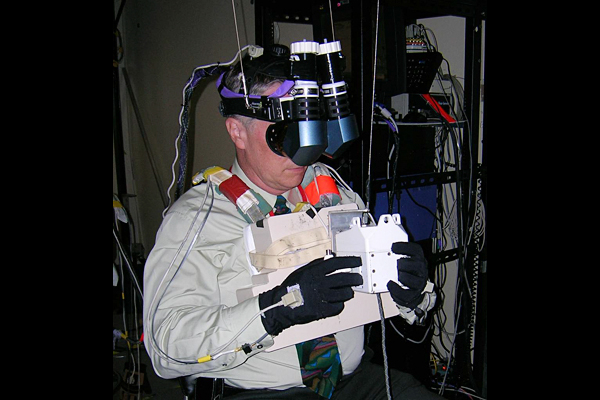Photo: Alex Lane, CC, flcikr.com
American author Stanley G. Weinbaum was one of the first writers to introduce the idea of virtual reality in his 1935 novel, Pygmalion’s Spectacles. Eighty years later the fictional technology has found some real-world applications at the University of Ottawa.
The research team includes Dr. Adam Sachs, a member of the Division of Neurosurgery at the University of Ottawa Brain and Mind Research Institute (uOBMRI) and clinician investigator at the Ottawa Hospital Research Institute, and postdoctoral fellow Chadwick Boulay, an expert in brain-computer interface.
Led by Dr. Sachs, the U of O scientists are using virtual reality goggles to relieve patients suffering from movement-related symptoms of Parkinson’s including rigidity, freezing, slow movements, and tremors.
The project
Dr. Sachs is a specialist in deep brain stimulation, a technology that uses electricity to stimulate parts of the brain to change some of the brain circuitry related to Parkinson’s, thus diminishing the symptoms of the disease.
Patients in Dr. Sachs’ experiment wear 3D goggles and see an image of their hand in virtual reality while researchers record associated neural activity. By changing variables and analyzing the responses to the brain, researchers can understand how these regions of the brain are treating different commands.
Since the symptoms of Parkinson’s change over time, Dr. Sachs sought to develop the virtual reality technology to respond to changes in brain activity, and adapt stimulation settings as appropriate for each moment in time. To achieve this, the researchers needed a better understanding of the language of the nuclei they were stimulating.
“The brain transforms movement in different reference frames flawlessly, and we want to understand how movements are initiated, how they change reference frames, and ultimately how muscles are controlled to create movements,” said Dr. Sachs.
The researchers also tested whether it’s possible to train patients to control the amount of brain activity.
“There are certain frequencies of activity that become increased during the (Parkinsonian) state and that’s referred to as the beta frequency,” said Dr. Sachs. To answer that question another experiment was modelled in which patients visualize a sphere in the virtual reality environment and are given instructions to try and control the colour of the sphere, something they can only do by changing the level of beta activity.
The result
Dr. Sachs’ work with virtual reality technology opens two new doors to treat the symptoms of Parkinson’s.
The first is a deep brain stimulation system that could be adapted to a patient’s brain activity, adapting to varying signals in the brain. The second is a treatment that would help patients learn how to control the activity of the subthalamic nucleus responsible for many adverse side effects associated with Parkinson’s.
What’s next?
Although the research is in its early stages, Dr. Sachs said he’s confident about this area of research by what he’s seeing in the results so far.
“I think that this is a line of scientific inquiry that we want to pursue. If patients can learn to control the brain activity that’s involved in Parkinson’s disease… then the next question is if they do that, do their movements become more smooth? And that’s exactly what we’ll be looking at.”
The next step will be to try to develop a stimulation system using brain biomarkers that would be responsive to the patient’s brain in real time. He also said he believes the brain-computer interface could be further developed to help patients suffering from spinal cord injuries or ALS.





